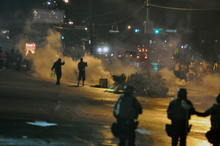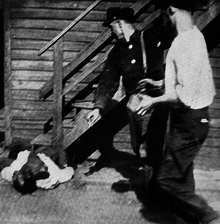Race riots in the United States

Race riots in the United States ( English Race Riots ) refers mainly to conflicts between African Americans and European Americans; they have been recorded since the end of the American Civil War, previously mostly as a slave revolt . However, the term racial unrest also refers to attacks against Chinese Americans , German Americans , Mexicans and other Hispanics , Native Americans , Irish Catholics , Italian Americans, and other immigrants.
history
Originally the term race riots was a euphemizing expression for pogrom-like attacks by white sections of the population on black citizens, for example the draft riots in New York in July 1863. The Irish and German immigrants there refused to comply with conscription for the civil war . They did not want to fight for the liberation of black slaves because they feared that they might take their jobs away later. In the wake of this race riot, African American citizens were indiscriminately lynched and an orphanage for black children burned down.
The following race riots took place mainly in the southern states , where one wanted to defend oneself against " Yankee occupiers" and " Negro rule ". In July 1866, heavily armed White Democrats, with the assistance of local police, attacked a multiracial Republican gathering in New Orleans . At least 38 people died.
In 1906, rumors of alleged rapes of white women provoked the Atlanta massacre . According to historian David F. Krugler, 32 African Americans died in the course of the riots. After these incidents, the "black fiends" were accused of the race riots shifted back into the Northern states : Because many African Americans in the Great Migration migrated in search of work in the agricultural south to the industrial cities of the North, it always came back to assault Whiter on black.
In East St. Louis , white workers raided the local black population in July 1917 after a local aluminum plant hired black scabs. Spurred on by rumors and conspiracy theories , in which both sides assumed they were planning a massacre, the riots finally broke out. Many houses were set on fire, large numbers of blacks fled the city and 50 African Americans died. The exact number of deaths has again been the subject of conspiracy theories because African Americans accused the authorities of keeping the real numbers a secret.
At the end of July 1919, the worst riots of the so-called Red Summer took place in over 30 cities in Chicago . After an incident in Lake Michigan drowned an African-American youth who was believed to have been thrown from a white-only beach, angry blacks attacked a police officer who had been watching. 23 blacks and 15 whites died in the Chicago riots. The red summer, which took its course in the already tense atmosphere of the First Red Fear , culminated in early October with the Elaine massacre in Phillips County, Arkansas , in which, according to witnesses, up to 200 African-American cotton pickers and tenant farmers were killed while they were a union wanted to form. The “Red Summer” is hardly dealt with legally or historically.
The violence continued in the 1920s, including in Rosewood , Florida. In 1921, the Tulsa massacre completely destroyed the Greenwood district ("Black Wall Street"). As a result of the immigration of African Americans to large cities and the associated ghettoization , on the one hand relationships with the whites changed , on the other hand, the sense of community and self-confidence increased, which offered a certain protection against attacks. There was relatively little racial unrest during the Great Depression . In Harlem in 1935 a new kind of riot emerged with opposite signs that became prototypical for the racial riots of the 1960s: When the rumor spread that a shoplifter had been shot by a policeman, black residents attacked policemen and shops owned by whites. In June 1943, 34 Detroiters died and another 700 were injured. In around 50 other cities in the United States, minor and major racial riots.
Until the 1960s, the racial riots were mainly whites. This changed with the ghetto riots. In 1964 riots broke out in Harlem ( New York City ) and in 1965 in Watts ( Los Angeles ). The following three years spared almost no major city in the USA. The 1967 Detroit race riot targeting white police violence resulted in 43 deaths. After the assassination of Martin Luther King on April 4, 1968, protests took place in around 170 cities, mainly in Baltimore and Washington, DC
In May 1980, 18 people died in race riots in Miami ; twelve years later, more than 50 people were killed in the so-called LA riots in Los Angeles . Then there were race riots again for the first time in 2014 - in Ferguson ( death of Michael Brown ) and Baltimore.
Other race riots
- 1871: A massacre takes place in Chinatown in Los Angeles , killing 18 Chinese immigrants.
- 1885: At least 28 Chinese miners are killed by European workers in Rock Springs , Wyoming .
- 1900: Akron riot in Akron, Ohio : While fighting off a mob trying to lynch an African-American suspect, the city police accidentally shoot two children. The only way to stop the riot is through the deployment of the Ohio State National Guard.
- 1902: Anti-Semitic riots take place in New York .
- 1907: During the Bellingham Riots 125 are Sikharbeiter of British India from Bellingham , Washington to British Columbia sold.
- 1927: In Poughkeepsie , New York , attacks on Puerto Ricans , Jews and Greeks occur in addition to attacks by the white population on blacks .
- 1984: Violent clashes break out between Hispanic American workers and other lower-class people in Lawrence , Massachusetts .
literature
- Peter B. Levy: The Great Uprising: Race Riots in Urban America during the 1960s. Cambridge University Press, Cambridge 2018, ISBN 978-1-108-43403-4 .
- Ann V. Collins: All Hell Broke Loose: American Race Riots from the Progressive Era through World War II. ABC-CLIO, Santa Barbara 2012, ISBN 978-0-313-39600-7 .
- Janet L. Abu Lughod: Race, Space, and Riots in Chicago, New York, and Los Angeles. Oxford University Press, New York 2012, ISBN 978-0-19-993655-7 .
- Lee E. Williams, Lee E. Williams II: Anatomy of Four Race Riots: Racial Conflict in Knoxville, Elaine (Arkansas), Tulsa, and Chicago, 1919-1921. University Press of Mississippi, Jackson 2010, ISBN 978-1-62846-732-1 .
- Walter C. Rucker, James N. Upton (Eds.): Encyclopedia of American Race Riots. Greenwood, Westport 2007, ISBN 0-313-33300-9 .
- Paul A. Gilje: Rioting in America. Indiana University Press, Bloomington 1999, ISBN 978-0-253-21262-7 , pp. 87-115 (= Chapter 4: The Tragedy of Race ).
Individual evidence
- ↑ a b c d e f Manfred Berg : Powder keg with a short fuse - The riots in Ferguson and Baltimore have an oppressive tradition: For more than 150 years 'race riots' have been shaking American society in Die Zeit on May 13, 2015, p. 17th
- ↑ David F. Krugler: 1919, The Year of Racial Violence: How African Americans Fought Back Cambridge University Press, New York 2015, ISBN 978-1-107-06179-8 , p. 13.
- ^ Ted Remington: African Americans . In: Peter Knight (Ed.): Conspiracy Theories in American History. To Encyclopedia . ABC Clio, Santa Barbara, Denver and London 2003, Vol. 1, p. 36.
- ^ Ted Remington: African Americans . In: Peter Knight (Ed.): Conspiracy Theories in American History. To Encyclopedia . ABC Clio, Santa Barbara, Denver and London 2003, Vol. 1, p. 36.
-
^ Ann V. Collins: Red Summer Race Riots. In Leslie M Alexander, Walter C. Rucker Jr. (Eds.): Encyclopedia of African American History. ABC-Clio, Santa Barbara 2010, ISBN 978-1-85109-769-2 , pp. 983-985; here: p. 984 .
Dominic J. Capeci, Jr .: Foreword: American Race Rioting in Historical Perspective. In: Walter C. Rucker, James N. Upton (Eds.): Encyclopedia of American Race Riots. S. xix-xliv; here: p. xxvii. - ↑ Saskia Etschmaier: The blood-red summer of the USA. In: orf.at . August 11, 2019, accessed January 24, 2020 .
- ↑ Dominic J. Capeci, Jr .: Foreword: American Race Rioting in Historical Perspective. In: Walter C. Rucker, James N. Upton (Eds.): Encyclopedia of American Race Riots. S. xix-xliv; here: S. xxviif.

